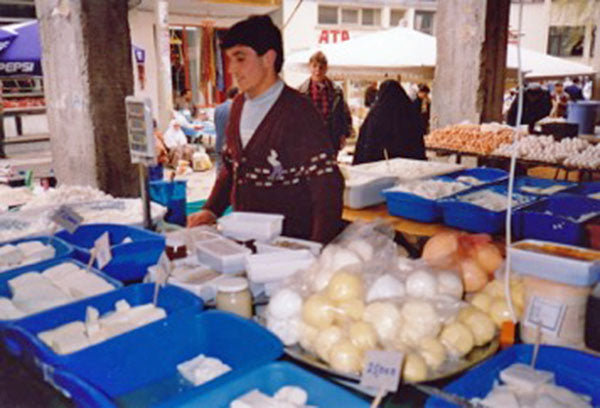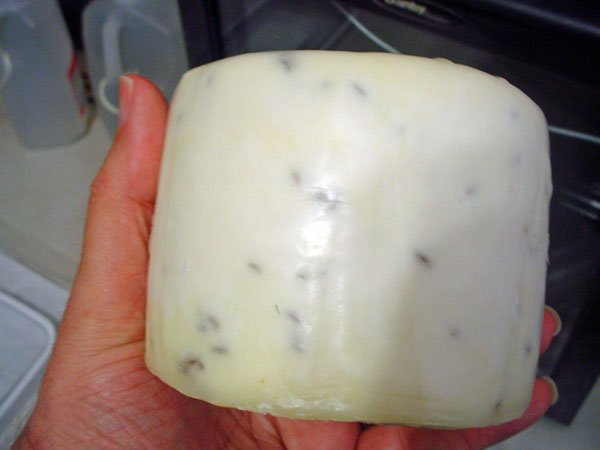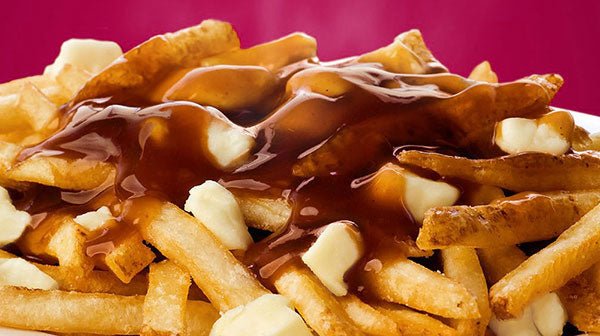
Adding culture and penicillium candidum to the milk for an ash covered bloomy rind goat’s milk cheese.
Growing Up
Tim: I grew up in a family that grew just about everything and preserved what was needed for the winter. My grandparents on my fathers side, made just about everything they needed. My grandmother, as I mentioned before, grew up on a self sustaining farm in Macksburg, Oregon (a small farming community in the northern part of the state).

My grandmother (right – Gertrude Barth Armstrong) and great grandmother (left – Sophie Barth) mending on the front porch of the family farm. Taken sometime in the 50s.
My grandfather grew up in a cowboy family in eastern Washington and at one time herded sheep with Basques along the eastern Washington, Oregon and Idaho border.

My grandmother and father creating their Victory Garden (Oregon Journal 1942).

As far as I can tell, the families arrived in Oregon in the late 1800s. Even after moving to Portland in 1916, they made their own soap, grew all their own vegetables, and kept bees in the foothills of the Cascade Mountain range where they had a cabin. I sold the honey door to door as a child.

Me, as a child, avoiding picking beans.
My grandfather was a home beer brewer throughout his life. During Prohibition, he also made a few batches of gin for the American Legion National Convention held in Portland in 1932.
I think it is this heritage that drives me to make whatever I can, rather than just buy it. I started brewing beer in college (before legal age admittedly) and attempted to make a still at age 16 (not successfully). It was easy to continue with fermenting and preserving, since that is what I had grown up with. As a child, I raised a few chickens and had a duck that wouldn’t lay eggs, but was willing to sit on some pheasant eggs we’d found in the field and raise them. Unfortunately, we don’t have the right place to do that now. I so admired my grandparent’s self-reliance, that we have made it a goal to live this life style whenever possible.
World Travels
In the late 80s, Carolyn and I decided to close a business we had been running for 13 years, go back to school to get degrees in teaching English as a second language and have an adventure someplace else in the world. We got jobs teaching at a Turkish university in central western Turkey where we lived for four years. Then we worked in Indonesia for a while before moving back to Oregon.

Cheese seller in Kutahya, Turkey 1990. Various boyar penir (feta) in front.
In 2000, we went back to Turkey to work at another university – this time in Istanbul. Later, we worked for the same university, but lived in a small fishing village on the Black Sea where the university had just built a new campus. Altogether, we lived and worked in Turkey for eight years starting in 1990 and off and on again until 2007.

My wife, Carolyn and I at a Phrygian ruin attributed to King Midas located in a small village 40 kilometers from the town of Eskisehir where we first lived and worked between 1990 and 1994. Taken sometime between 2005 and 2007.
We fell in love with Turkish cuisine and the incredible variety of Turkish cheeses that are almost never found outside the country. One of our goals in our cheese making is to perfect recipes for some of our favorite cheeses. This will be quite a project since there are at least 20 different types of beyaz peynir (“white cheese” or Turkish Feta) alone.

Cheese vendor in Istanbul, Turkey 2000. The cheese comes from Kars in the far eastern end of Turkey. The sign says that it is aged full fat cheese. It would typically be called a Kasar (pronounced Kashar) cheese. This is almost always cow’s milk cheese.
Fortunately, we will be able to ask for help from former Turkish colleagues and we have a reference book on the various cheeses. The difficult part will be to duplicate the flavors. All small producer cheeses in Turkey use either sheep, goat, or cow’s milk from pasture raised animals — and pastures in Turkey have a whole lot of differences from one end of the country to the other. We are still trying to find a source of sheep’s milk locally, but the southern Willamette Valley, where Eugene is located, is a Mecca for small farmers, so it is just a matter of making the right connections.
Tulum was the one of the most interesting cheeses we had in Turkey. It was scooped directly into a plastic bag for us from the hairy black goat’s hide bag it aged in. Tulum just means casing in Turkish and there can be a lot of regional variations. Our favorite was this crumbly, fairly dry cheese, which was perfect for salads.
Garden
We have a small garden space, but have designed it for the maximum yield for the space. We are able to get vegetables of some sort or another for about 10 months of the year — thanks to Oregon’s climate. The three pictures below show about 1/2 of our garden which is spread all around the house.



We preserve, ferment, and dry the surplus and buy a minimal amount of what else we need. We are blessed with having a huge number of small farmers in the area — the southern Willamette Valley being one of the best growing environments on the planet. We are able to buy wheat, beans, and lentils grown just a few miles from us and can get locally raised chicken, duck, lamb, rabbit, and pork (fed on hazelnuts) readily. About five years ago, we started curing our own salamis, hams, duck breasts, and other meats.
Beginning to make cheese
It seemed only logical to try cheese making. Initially, we had no idea of whether this would be complicated or not. I tend to be a bit of a nerd about the science of things, so I started researching the process. It seemed that there was a lot to keep track of and do just right, so we put it off for a while. Then, I thought, “why not just jump in?” (The only thing that could happen is that we would throw something out.)

Carolyn stirring and cooking the cheddar.
My wife, Carolyn, and I tackle the cheese making as a team. I admit that I had to talk her into it since on the surface it seems difficult, but now that we’ve made a dozen or so cheeses, she’s all in. We are making small (one gallon) batches at the moment. We may graduate to larger batches, but for the moment, a one-gallon of milk cheese is a size that works well.
New ventures can always be “interesting.” Our very first attempt at an acid-set cheese was not as expected. The recipe we followed hadn’t been checked carefully and called for three times as much vinegar as actually needed (and a couple of other issues). Still, it came out as something we could use in stir fries or egg dishes. No loss, but a lesson learned.
Our second attempt was a wonderful paneer. We oil cured this with herbs and spices and still nibble away at it.

Paneer in olive oil with herbs
Then, it was on to a chèvre which was a a huge success (and has been batch after batch). We then “graduated” to a goat’s milk Gouda and a cheddar (made from cream-line, grass fed cow’s milk). Both are still aging, but we may try the cheddar soon. We’ve made two batches of a goat’s milk Bulgarian style feta. The first was okay and the second a failure, but only in the sense that it was too soft. We ate all of it, so it was not technically a failure.
Press
I was a custom furniture designer and builder for many years, so the woodworking part was pretty easy. My first time using it, I forgot to take into account the natural weight of the press arm itself — which is about 5 pounds. This resulted in a very firm press once I added the weight recommended by the recipe for a goat’s milk Gouda. This fortunately, has not seemed to have any adverse affect on the cheese. I’ve since re-calibrated and have made a Parmesan style cheese which is aging now (it is hard to wait!).

Dutch cheese press. Before realizing that the arm equaled 5 pounds of weight without any extra weight. Since re-calibrated.

First effort at a goat’s milk Gouda. The extra weight from the press did not seem to be a problem.
Humidity Control
Recently, we solved the problem of maintaining the right level of humidity on our cheese “cave” when I remembered a long disused digital humidity and temperature controller we had once used in a seed starting greenhouse. Lo and behold, it works well with the small humidifying device we recently purchased (under $9). I dialed in the 90% needed for the ash covered, bloomy cheese and it maintains it.

The ash covered cheese starting to bloom. The device on the far right is the humidifier. The black device near the cheese is the sensor. The humidifier is plugged into the sensor control.


Parmesan in our Goodwill “cheese cave” ($15) with our travel humidifier that runs off a cell phone charger. Still trying to get the timing down right to maintain certain levels of humidity, but getting better all the time.
Current projects
Last week, we made ash covered bloomy cheese. Acid developed just right and the initial flavor is very good. The ash is messy, but we managed to get the cheese salted and covered with ash without making a complete mess. For us, this is unusual.

Draining the bloomy rind cheese. We added ash at the half full mark. Boards, matts and butter muslin for the flipping of the cheese — which we did every hour or so. We did drain the curds for several hours before putting in the mold, but a lot of whey still drained after molding. The cheese boards are made from left over maple flooring.

The first turning of the bloomy rind cheese. Everything worked as it was supposed to and with subsequent flips as well. The ash from the middle started to spread a bit and with each turn coated the sides of the cheese. The result was that when we removed the cheese from the mold, the side coating was about 75% done! Just added salt.

The final ash covered bloomy ring cheese set up for drying before heading to the cheese cave.

Ash covered bloomy rind after 3 days
We will soon be tasting our first cheddar. This was made from a local cream line, grass fed cows milk. Our next cheddar will probably be left to age a bit longer, but it is difficult for beginning cheese makers to wait to see if we’re on track or not.
Current issues
Sometimes figuring out how to scale a recipe down from larger ones is a challenge. I used to have a very accurate gram scale that could measure very small amounts, but that is long gone. Now I have to make due with a digital scale that doesn’t do very small amounts. Although, one thing I have learned from my dry salami making is that too much culture is better than too little.

Our first attempt at a Parmesan style cheese. Aged about three weeks.
By the way, there is a product created for meat curing that may have some use in cheese making. The manufacturer is Umai. They produce a vacuum seal bag that allows moisture to transfer in one direction. It bonds with the protein in meat and may bond with the proteins in milk. It prevents mold from forming on the dry salami I make and gives a predictable, controlled drying time. It wouldn’t let a natural rind form, but it would replace oiling or waxing. I will experiment with it on the next hard cheese we make and let you know.

As I said, we are rank beginners with cheese, but have decades of experience with fermentation, brewing, and meat curing. Early on, I learned a lot from my grandmother who was of a pioneering family in Oregon and grew up on a subsistence farm. Learning is fun and rewarding. Failures that are edible are not failures — just learning experiences.
We rely a lot on your web site for learning and recipes — thanks so much. We are willing to experiment and have already tried some things that weren’t in original recipes — so far with good results. Fortunately, from our other food adventures, we recognize good mold from bad and can deal with it.













































































































































